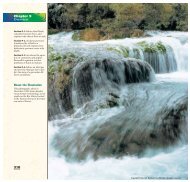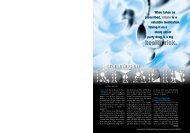Induction and Alternating Current with teacher's notes
Induction and Alternating Current with teacher's notes
Induction and Alternating Current with teacher's notes
You also want an ePaper? Increase the reach of your titles
YUMPU automatically turns print PDFs into web optimized ePapers that Google loves.
SECTION 22-1<br />
Demonstration 1<br />
Induced current<br />
Purpose Show students an<br />
example of an induced current.<br />
Materials flashlight bulb in<br />
holder, coil of wire, bar magnet<br />
(two may be required), connecting<br />
wires<br />
Procedure Connect the flashlight<br />
bulb to the coil of wire <strong>with</strong> the<br />
connecting wires. Tell students to<br />
observe the demonstration <strong>with</strong><br />
the intent of explaining the energy<br />
conversions. Move the bar<br />
magnet into <strong>and</strong> out of the coil<br />
several times in rapid succession.<br />
Have students explain the energy<br />
conversions on the board or in<br />
their notebooks. The following<br />
energy conversions should be<br />
discussed: kinetic energy is converted<br />
to electrical energy (moving<br />
magnet generates a current)<br />
<strong>and</strong> electrical energy is converted<br />
to light (the current heats the<br />
light bulb’s filament).<br />
796<br />
In 1996, the space shuttle Columbia<br />
attempted to use a 20.7 km conducting<br />
tether to study Earth’s magnetic<br />
field in space. The plan was to<br />
drag the tether through the magnetic<br />
field, inducing an emf in the<br />
tether. The magnitude of the emf<br />
would directly vary <strong>with</strong> the<br />
strength of the magnetic field.<br />
Unfortunately, the tether broke<br />
before it was fully extended, so the<br />
experiment was ab<strong>and</strong>oned.<br />
Table 22-1 Ways of inducing a current in a circuit<br />
796<br />
Chapter 22<br />
Change in the number of magnetic field lines induces a current<br />
So far, you have learned that moving a circuit loop into or out of a magnetic<br />
field can induce an emf <strong>and</strong> a current in the circuit. Changing the size of the<br />
loop or the strength of the magnetic field also will induce an emf in the circuit.<br />
One way to predict whether a current will be induced in a given situation<br />
involves the concept of changes in magnetic field lines. For example, moving<br />
the circuit into the magnetic field causes some lines to move into the loop.<br />
Changing the size of the circuit loop or rotating the loop changes the number<br />
of field lines passing through the loop, as does changing the magnetic field’s<br />
strength. Table 22-1 summarizes these three ways of inducing a current.<br />
CHARACTERISTICS OF INDUCED CURRENT<br />
Suppose a bar magnet is pushed into a coil of wire. As the magnet moves into<br />
the coil, the strength of the magnetic field <strong>with</strong>in the coil increases, <strong>and</strong> a current<br />
is induced in the circuit. This induced current in turn produces its own<br />
magnetic field, whose direction can be found by using the right-h<strong>and</strong> rule. If<br />
you were to apply this rule for several cases, you would notice that the induced<br />
magnetic field direction depends on the change in the applied field.<br />
As the magnet approaches, the magnetic field passing through the coil<br />
increases in strength. The induced current in the coil must be in a direction<br />
that produces a magnetic field that opposes the increasing strength of the<br />
approaching field. The induced magnetic field is therefore in the direction<br />
opposite that of the approaching magnetic field.<br />
Description Before After<br />
Circuit is moved into or out of magnetic<br />
field (either circuit or magnet moving).<br />
Circuit is rotated in the magnetic field<br />
(angle between area of circuit <strong>and</strong><br />
magnetic field changes).<br />
Intensity of magnetic field is varied.<br />
v<br />
B<br />
B<br />
I<br />
v<br />
B<br />
I B<br />
I<br />
Copyright © by Holt, Rinehart <strong>and</strong> Winston. All rights reserved.<br />
B
















